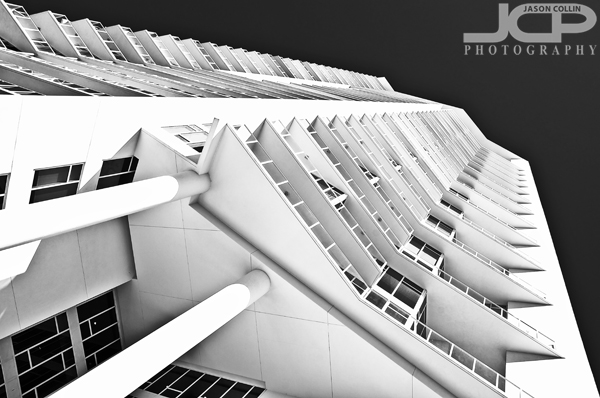 When looking to make a photograph remember to also look up!Pushing the shutter on your camera when looking at a subject at eye level with nothing else special done is very likely to result in an uninteresting photograph. Shooting like these I often refer to as just snapshot photography. I tell my photography students that to make a photograph one often has to show the viewer something she/he cannot also see simply by standing there too. One of the easiests ways to compose a shot that breaks from this constraint is to simply look, up! A sharp eyed viewer will also notice one of my other favorite composition techniques in the above shot of Signature Tower in downtown St. Petersburg--ending lines flush in corners.
When looking to make a photograph remember to also look up!Pushing the shutter on your camera when looking at a subject at eye level with nothing else special done is very likely to result in an uninteresting photograph. Shooting like these I often refer to as just snapshot photography. I tell my photography students that to make a photograph one often has to show the viewer something she/he cannot also see simply by standing there too. One of the easiests ways to compose a shot that breaks from this constraint is to simply look, up! A sharp eyed viewer will also notice one of my other favorite composition techniques in the above shot of Signature Tower in downtown St. Petersburg--ending lines flush in corners.
architecture
High Contrast Red Filter turns blue sky to night in Silver Efex Pro
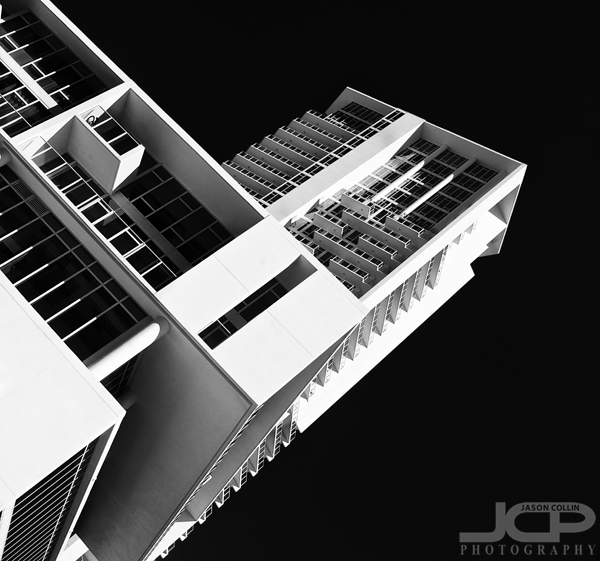 Signature Place in downtown St. Petersburg Florida - Nikon D300 Tamron 17-50mm @ f/11 ISO 200 1/320th with high contrast red filter in Silver Efex Pro appliedWhen teaching photography at night I often tell my DSLR photography lessons students that with long exposures you can turn night into day. Well, with a high contrast red filter, you can do the harder reverse of that, which would be turning day into night! It is actually not hard if you have the awesome Silver Efex Pro plugin, which I have been raving about for years.
Signature Place in downtown St. Petersburg Florida - Nikon D300 Tamron 17-50mm @ f/11 ISO 200 1/320th with high contrast red filter in Silver Efex Pro appliedWhen teaching photography at night I often tell my DSLR photography lessons students that with long exposures you can turn night into day. Well, with a high contrast red filter, you can do the harder reverse of that, which would be turning day into night! It is actually not hard if you have the awesome Silver Efex Pro plugin, which I have been raving about for years.
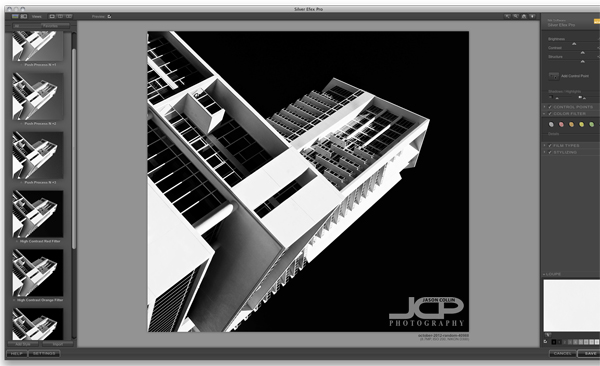 The Nik Silver Efex Pro interface with high contrast red filter applied to the imageFirst I went through my normal digital photo editing workflow on this architecture shot of Signature St. Petersburg. I made a duplicate and sent it into Silver Efex Pro. From there all that needed to be done to change the color image to black & white and the blue sky into a night one was to click on the high contrast red filter preset. No mess, no fuss.
The Nik Silver Efex Pro interface with high contrast red filter applied to the imageFirst I went through my normal digital photo editing workflow on this architecture shot of Signature St. Petersburg. I made a duplicate and sent it into Silver Efex Pro. From there all that needed to be done to change the color image to black & white and the blue sky into a night one was to click on the high contrast red filter preset. No mess, no fuss.
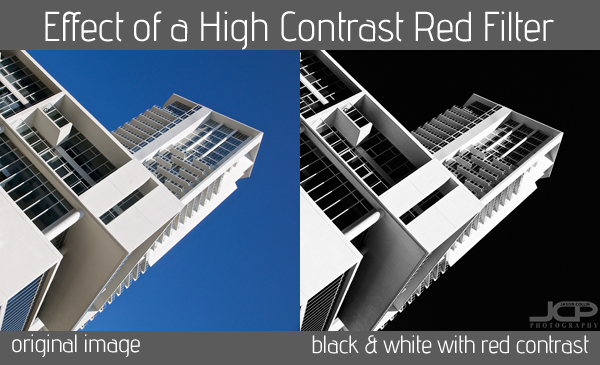
Bird's Eye View of Tokyo from Shinjuku Nikon Headquarters Black & White
 Bird's eye view of Tokyo from Nikon Headquarters in Shinjuku - Nikon D80 Tamron 17-50mm @ f/11 ISO 200 1/40thAll you see above I could navigate precisely on foot, by bike or on train, for this was my home neighborhood for six years. Yet I never saw it from so high above until the very end of my time there. If it looks like a maze I can assure you it most certainly was. Passing through it on foot or by train was a constant series of turns, not just left and right, but also up and down in and out of stations, underground street passages and long, very long tunnels. By far the fastest way to get from point A to point B was by bike, especially if one had the nerve to ride out in traffic, though by day or night I only ever found a section of about a quarter mile of road in that entire maze to be risky to ride on.
Bird's eye view of Tokyo from Nikon Headquarters in Shinjuku - Nikon D80 Tamron 17-50mm @ f/11 ISO 200 1/40thAll you see above I could navigate precisely on foot, by bike or on train, for this was my home neighborhood for six years. Yet I never saw it from so high above until the very end of my time there. If it looks like a maze I can assure you it most certainly was. Passing through it on foot or by train was a constant series of turns, not just left and right, but also up and down in and out of stations, underground street passages and long, very long tunnels. By far the fastest way to get from point A to point B was by bike, especially if one had the nerve to ride out in traffic, though by day or night I only ever found a section of about a quarter mile of road in that entire maze to be risky to ride on.
When friends visited it was a point of pride to lead them on a dizzying path through routes that took months to learn.
I made this photograph from the Nikon Headquarters high up in a skyscraper in Shinjuku, the hub of Tokyo, if not its heart. I lived a 10-minute walk from here, which in Tokyo walking time, is a short distance. You could get hands on with every lens Nikon makes and also bring your Nikon DSLR in for a free sensor cleaning if it was still within warranty. You were also treated to the view you see above. I of course had to shoot through windows to make this shot. I erased the spots on the windows visible in the sky portion of the photo.
If you can believe it, this place felt as much like home to me as any place I have ever lived.
Look for repeating patterns in architecture shots
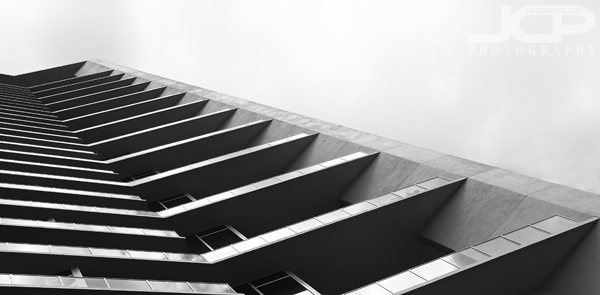 Using balconies as a repeating pattern composition - Signature St. Petersburg tower - Nikon D300 Tamron 17-50mm @ f/11 ISO 200 1/500th - black & white processing using Silver Efex ProFinding and using repeating patterns in your photographs is my photography tip for this week. In the above photograph of Signature St. Petersburg I composed the shot to exaggerate row after row of balconies so that they came to form a repeating pattern. I also held my camera off-angle to create a leading line with the far edge of the skyscraper and also the interior contour that leads the viewer's eye from lower right to upper left. Thus, in this architecture shot I combined repeating patterns with leading lines in an attempt to produce an interesting photograph.
Using balconies as a repeating pattern composition - Signature St. Petersburg tower - Nikon D300 Tamron 17-50mm @ f/11 ISO 200 1/500th - black & white processing using Silver Efex ProFinding and using repeating patterns in your photographs is my photography tip for this week. In the above photograph of Signature St. Petersburg I composed the shot to exaggerate row after row of balconies so that they came to form a repeating pattern. I also held my camera off-angle to create a leading line with the far edge of the skyscraper and also the interior contour that leads the viewer's eye from lower right to upper left. Thus, in this architecture shot I combined repeating patterns with leading lines in an attempt to produce an interesting photograph.
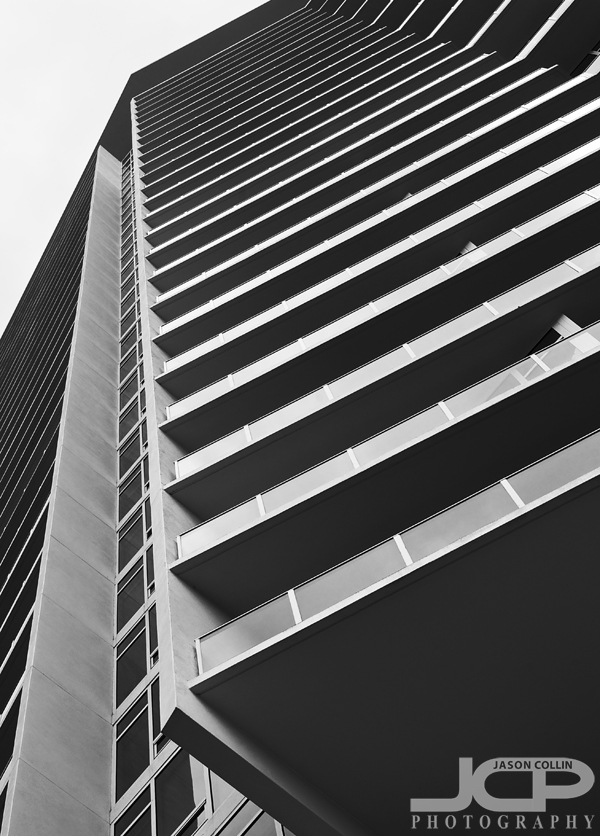 Once again using leading lines and repeating patterns to create interest - Nikon D300 Tamron 17-50mm @ f/11 ISO 200 1/200th - black & white processing in Silver Efex ProI used the exact same techniques in composing this architecture shot as well, just put into portrait orientation. In composing and later in cropping, I paid special attention to make sure each leading line ended exactly at the edge of the frame. Note how the lower left the line ends right into the corner, and for the small line in the upper right, just before the roof went upwards to the right, I cropped it there to keep the line straight.
Once again using leading lines and repeating patterns to create interest - Nikon D300 Tamron 17-50mm @ f/11 ISO 200 1/200th - black & white processing in Silver Efex ProI used the exact same techniques in composing this architecture shot as well, just put into portrait orientation. In composing and later in cropping, I paid special attention to make sure each leading line ended exactly at the edge of the frame. Note how the lower left the line ends right into the corner, and for the small line in the upper right, just before the roof went upwards to the right, I cropped it there to keep the line straight.
Lastly, I chose black & white processing for both these images because there was cloud cover and the building itself lacks color, so no reason to leave what little color was left in the image.
Nikon D90 Architecture Photography Lesson in St. Petersburg Florida with Bill
 Bill with his Nikon D90 practicing architecture photography outside of Signature Tower in downtown St. PetersburgMy third DSLR Photography Lesson with Bill on Saturday morning was our first 1-on-1 lesson as his wife Ria could not make it for this one. We met at the usual spot in downtown St. Petersburg on a typcially beautiful, sunny and warm Florida spring morning. The focus for this lesson was on making architecture shots, and how to use aperture priority mode to get a general idea of the exposure wanted, before switching to manual mode to fine tune it exactly to the desired results.
Bill with his Nikon D90 practicing architecture photography outside of Signature Tower in downtown St. PetersburgMy third DSLR Photography Lesson with Bill on Saturday morning was our first 1-on-1 lesson as his wife Ria could not make it for this one. We met at the usual spot in downtown St. Petersburg on a typcially beautiful, sunny and warm Florida spring morning. The focus for this lesson was on making architecture shots, and how to use aperture priority mode to get a general idea of the exposure wanted, before switching to manual mode to fine tune it exactly to the desired results.
At the very beginning Bill showed me some shots of the St. Petersburg skyline and waterfront he took since our last lesson, homework so to speak. This was very useful to me in being able to show Bill which settings were correct, and which ones needed to be changed in order to produce a better shot. We then simulated some of those shot circumstances during our lesson so Bill could practice getting all settings correct for better results.
We had time during this lesson to start to discuss composition more, especially when photographing buildings. I showed Bill my parallel edge photography tip while saying that the entire building does not always need to be in the frame.
Our next lessons will start to include digital photography editing in addition to more shooting practice. I am looking forward to seeing Bill's early morning dawn shots of St. Petersburg with the help of the things we practiced this lesson.
Architecture Photography Tip put building edge parallel to edge of the frame

This photography tip is about how to frame architecture shots with regards to the sides of the frame. When photographing a skyscraper like the one above, I like to get the opposite edge (in this case the left) of where the building starts from to end with a part of the building parallel to that edge.
In the shot on the right, the top of the building is at an angle to the left of the frame. To me this looks awkward and makes the viewer's eye uncomfortable when following the lines of the skyscraper. In the shot on the left, I composed so that the top of the building ended up parallel to the left (opposite edge) of the frame. The viewer's eye starts from right to left and continues up through the top of the frame.
What do you think about this small, but important composition detail?
Downtown Tampa Architecture & Landmarks in Black and White
 Sykes Building downtown Tampa Florida black & white - Nikon D300 Tamron 17-50mm @ f/11 ISO 200 7-exposure HDR on tripod with cable releaseAfter shoots for specific client requests I often find I can create a subsequent set of images from the remaining shots. Such is the case with these black & white photographs featuring downtown Tampa and surrounding areas and landmarks. The client wanted landscape orientated shots for a use in an existing website template. Still, while out making those images I did rotate my DSLR to produce a few portrait orientated ones just in case the client might have a need for them and also just because I thought they would make cool shots and did not want to leave any unmade photographs that I saw the potential for.
Sykes Building downtown Tampa Florida black & white - Nikon D300 Tamron 17-50mm @ f/11 ISO 200 7-exposure HDR on tripod with cable releaseAfter shoots for specific client requests I often find I can create a subsequent set of images from the remaining shots. Such is the case with these black & white photographs featuring downtown Tampa and surrounding areas and landmarks. The client wanted landscape orientated shots for a use in an existing website template. Still, while out making those images I did rotate my DSLR to produce a few portrait orientated ones just in case the client might have a need for them and also just because I thought they would make cool shots and did not want to leave any unmade photographs that I saw the potential for.
 Tampa Theater marquee in black & white - Nikon D300 Tamron 17-50mm f/11 ISO 200 1/25th single exposure tripod mounted with cable releaseThe client actually chose the above image of Tampa Theatre, which did not standout to me personally in my initial culling, but after editing and convesion to black & white I kind of liked it because of the below eye level composition. I closed my tripod's legs to use only about half of its full height shooting from just around my own waist level.
Tampa Theater marquee in black & white - Nikon D300 Tamron 17-50mm f/11 ISO 200 1/25th single exposure tripod mounted with cable releaseThe client actually chose the above image of Tampa Theatre, which did not standout to me personally in my initial culling, but after editing and convesion to black & white I kind of liked it because of the below eye level composition. I closed my tripod's legs to use only about half of its full height shooting from just around my own waist level.
 The new Tampa Museum of Art with krew on Hillsborough River - Nikon D300 Tamron 17-50mm @ f/11 ISO 200 1/250th single exposure tripod mounted with cable releaseThe new Tampa Museum of Art building is very modern looking in person. However, I thought in the photograph above its rectangular architecture made it look more like buildings from the 1950s, especially in black & white. I saw the crew rowing team and waited for them to come into the shot to make the composition I wanted.
The new Tampa Museum of Art with krew on Hillsborough River - Nikon D300 Tamron 17-50mm @ f/11 ISO 200 1/250th single exposure tripod mounted with cable releaseThe new Tampa Museum of Art building is very modern looking in person. However, I thought in the photograph above its rectangular architecture made it look more like buildings from the 1950s, especially in black & white. I saw the crew rowing team and waited for them to come into the shot to make the composition I wanted.
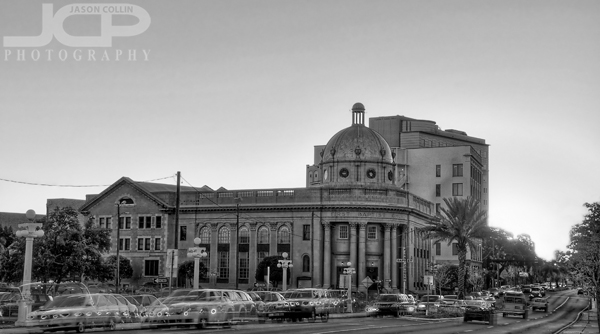 Tampa First Baptist Church with traffic in black & white - Nikon D300 Tamron 17-50mm @ f/11 ISO 200 7-exposure HDR tripod mounted with cable releaseI had no idea the above building was the Tampa First Baptist Church. I saw people coming and going from it while I was in the area over the course of the afternoon and thought it was a courthouse or some other type of government building. Even while editing it I never even noticed the largest FIRST BAPTIST CHURCH engraved on top of the columns. I had to look up which building it was in Google to surprisingly find out it was a church.
Tampa First Baptist Church with traffic in black & white - Nikon D300 Tamron 17-50mm @ f/11 ISO 200 7-exposure HDR tripod mounted with cable releaseI had no idea the above building was the Tampa First Baptist Church. I saw people coming and going from it while I was in the area over the course of the afternoon and thought it was a courthouse or some other type of government building. Even while editing it I never even noticed the largest FIRST BAPTIST CHURCH engraved on top of the columns. I had to look up which building it was in Google to surprisingly find out it was a church.
 Tampa Downtown Skyscraper Skyline View in black & white - Nikon D300 Tamron 17-50mm @ f/11 ISO 200 7-exposure HDR tripod mounted with cable releaseThis last photograph is of a much more familiar and oft-photographed subject matter, the downtown Tampa skyline featuring the unique skyscraper in the center, the cylindrical Sykes Building. The moon can be seen rising in the upper left of the image.
Tampa Downtown Skyscraper Skyline View in black & white - Nikon D300 Tamron 17-50mm @ f/11 ISO 200 7-exposure HDR tripod mounted with cable releaseThis last photograph is of a much more familiar and oft-photographed subject matter, the downtown Tampa skyline featuring the unique skyscraper in the center, the cylindrical Sykes Building. The moon can be seen rising in the upper left of the image.
I encourage everyone to go through past shoots and see if you can find a whole different photo story than the intended purpose of the shoot from the remaining images. Be sure and post a link to it in the comments below.
 |
 |

